The Greek Model, Axia Andreadaki poses nude and here are her recent pictures. Its smokin HOT









The Greek Model, Axia Andreadaki poses nude and here are her recent pictures. Its smokin HOT









Estos días estoy editando nuevas y viejas fotos que muy pronto estarán en la sección “galería” de mi web oficial en forma de series de 3 o 4 imágenes.
These days I’m editing new and old pictures that soon will be published in the “gallery” section of my official website in series of 3 or 4 frames.
An example.

Visit Calvin Dexter Photography for more.
Ashton Moore (born March 31, 1976 in Newport Beach, California) is an American pornographic actress.
Moore was a ClubJenna contract girl from 2005 until 2007.






Adriana Lima is nude and gorgeous in this month’s GQ Magazine, but it’s nothing compared to her fully nude featured film!
Okay, okay, that doesn’t exactly exist… yet! But you can imagine what it would be like. But Adriana is absolutely perfect and seeing her like this on the beach really just made me want to enjoy these pictures, along with a number of photos from older picture sets… which can and should be taken as somewhat of a tribute to her perfect body! Ahh, there’s really nothing else to say, I’ll just let Adriana do the talking from this point forward! Enjoy!


























Anything to shift sales as of now. Rated R is as stale as old bread. Everyones, seen her naked photos anyway. Well, Rihanna is on the cover with her tittays almost out. A better picture will be posted once one surfaces. The word our on the blog block is that Rihanna’s record company is already readying up a re-packaged Rated R to boost sales.
Firstly, an unrelated note here. I know I have neglected this blog for a long time, and I really do regret it. I will try harder from now on. Oh, and my main blog is here, so you might want to take a look.
My last post in my main blog was about iGoogle (Google’s customizable page). I use the tea house theme for my own iGoogle, which I think is wonderful because it changes all the time. I love foxes and the illustration of this particular fox is amazingly cute. Plus it changes during the day. You can see the different illustrations of the upper bar during the different times of the day in the post on my main blog. You might have noticed the spirits there at 03:14 who eat the oranges which are offerings, they are some kind of a Yōkai which are a class of preternatural creatures in Japanese folklore ranging from the evil oni (ogre) to the mischievous kitsune (fox) or snow woman Yuki-onna.
Here are some Yōkai images that were illustrated during the Edo period. They are ukiyo-e prints, which are Japanese woodblock prints or paintings.

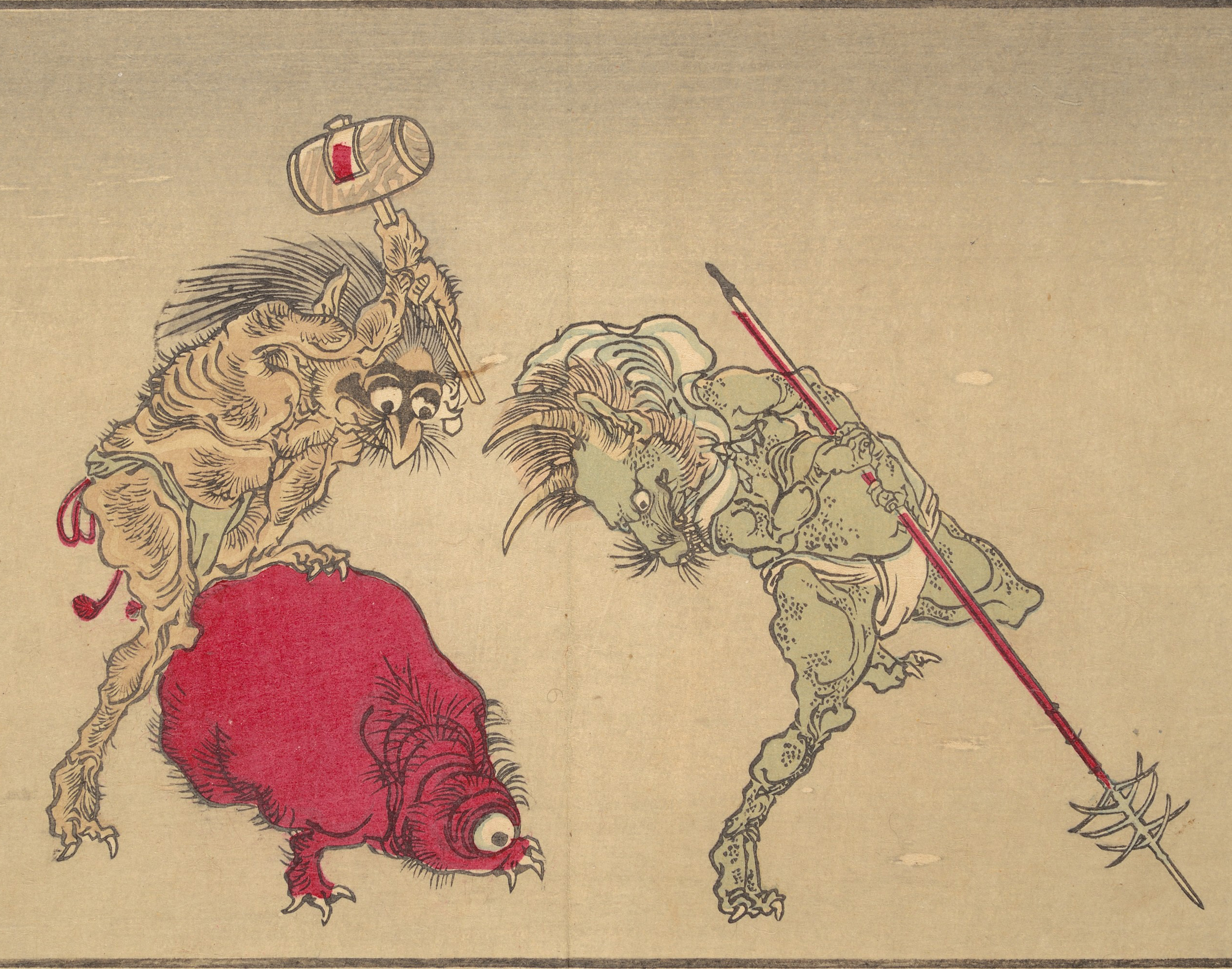

Below is a Kappa, which is a type of water sprite found in Japanese folklore.

Below, there are images of Tengu (天狗?, “heavenly dogs”) which are a class of supernatural creatures found in Japanese folklore, art, theater, and literature. They are one of the best known yōkai (monster-spirits) and are sometimes worshipped as Shinto kami (revered spirits or gods). Although they take their name from a dog-like Chinese demon (Tiangou), the tengu were originally thought to take the forms of birds of prey, and they are traditionally depicted with both human and avian characteristics. They appear in the children’s story Banner in the sky when the main character trips over one and falls off the face of the mountain. The earliest tengu were pictured with beaks, but this feature has often been humanized as an unnaturally long nose, which today is practically the tengu’s defining characteristic in the popular imagination.
Buddhism long held that the tengu were disruptive demons and harbingers of war. Their image gradually softened, however, into one of protective, if still dangerous, spirits of the mountains and forests. Tengu are associated with the ascetic practice known as Shugendō, and they are usually depicted in the distinctive garb of its followers, the yamabushi.


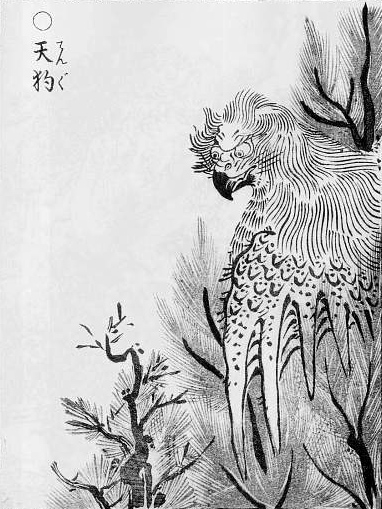


To add some more differentiation to Yokai, there are also my favorite types, the Kitsune and the Yuki-onna:
Kitsune, 狐, きつね is the Japanese word for fox. Foxes are a common subject of Japanese folklore; kitsune usually refers to them in this context. Stories depict them as intelligent beings and as possessing magical abilities that increase with their age and wisdom. Foremost among these is the ability to assume human form. While some folktales speak of kitsune employing this ability to trick others—as foxes in folklore often do—other stories portray them as faithful guardians, friends, lovers, and wives.
Foxes and human beings lived in close proximity in ancient Japan; this companionship gave rise to legends about the creatures. Kitsune have become closely associated with Inari, a Shinto kami or spirit, and serve as his messengers. This role has reinforced the fox’s supernatural significance. The more tails a kitsune has—they may have as many as nine—the older, wiser, and more powerful it is. Because of their potential power and influence, some people make offerings to them as to a deity.

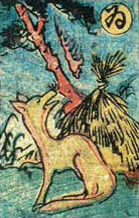
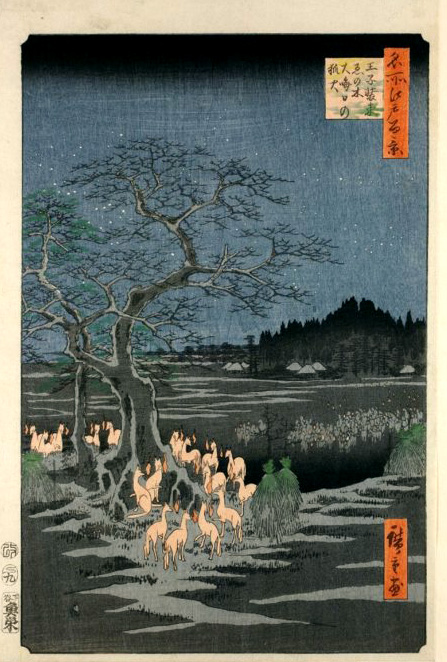
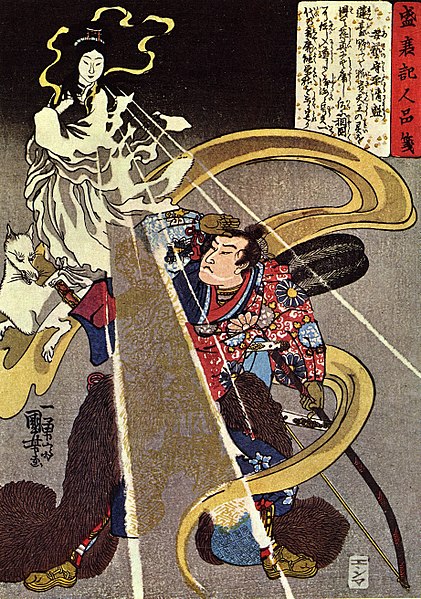
Yuki Onna (雪女, snow woman) is a spirit or yōkai in Japanese folklore. She is a popular figure in Japanese animation, manga, and literature.
Yuki-onna appears on snowy nights as a tall, beautiful woman with long hair. Her inhumanly pale or even transparent skin makes her blend into the snowy landscape (as famously described in Lafcadio Hearn’s Kwaidan: Stories and Studies of Strange Things). She sometimes wears a white kimono,but other legends describe her as nude, with only her face and hair standing out against the snow.Despite her inhuman beauty, her eyes can strike terror into mortals. She floats across the snow, leaving no footprints (in fact, some tales say she has no feet, a feature of many Japanese ghosts), and she can transform into a cloud of mist or snow if threatened.
Some legends say the Yuki-onna, being associated with winter and snowstorms, is the spirit of someone who perished in the snow. She is at the same time beautiful and serene, yet ruthless in killing unsuspecting mortals. Until the 18th century, she was almost uniformly portrayed as evil. Today, however, stories often color her as more human, emphasizing her ghost-like nature and ephemeral beauty.
In many stories, Yuki-onna appears to travelers trapped in snowstorms, and uses her icy breath to leave them as frost-coated corpses. Other legends say she leads them astray so they simply die of exposure. Other times, she manifests holding a child. When a well-intentioned soul takes the “child” from her, they are frozen in place.Parents searching for lost children are particularly susceptible to this tactic. Other legends make Yuki-onna much more aggressive. In these stories, she often invades homes, blowing in the door with a gust of wind to kill residents in their sleep (Some legends require her to be invited inside first.)
What Yuki-onna is after varies from tale to tale. Sometimes she is simply satisfied to see a victim die. Other times, she is more vampiric, draining her victims’ blood or “life force.” She occasionally takes on a succubus-like manner, preying on weak-willed men to drain or freeze them through sex or a kiss.
Like the snow and winter weather she represents, Yuki-onna has a softer side. She sometimes lets would-be victims go for various reasons. In one popular Yuki-onna legend, for example, she sets a young boy free because of his beauty and age. She makes him promise never to speak of her, but later in life, he tells the story to his wife who reveals herself to be the snow woman. She reviles him for breaking his promise, but spares him again, this time out of concern for their children (but if he dares mistreat their children, she will return with no mercy. Luckily for him, he is a loving father).In a similar legend, Yuki-onna melts away once her husband discovers her true nature.
